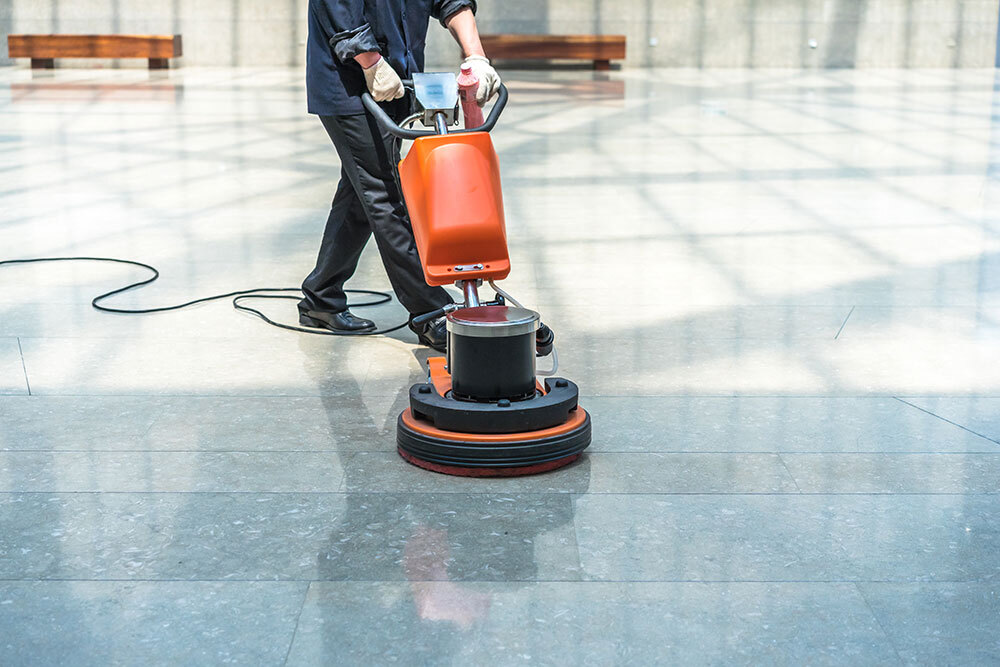Concrete is the most preferred floor surface by homeowners, commercial buildings, and offices due to its durability and performance. Polished concrete is a progressive process of mechanical grinding, honing, and polishing. Polishing is done to achieve an aesthetically pleasing, long-lasting, and high gloss finish surface. Each polishing process is then broken down into multiple steps involving finner grits abrasives and the use of densifiers. The method of polishing is more technical than most realize. The polish quality depends on; quality of equipment used, the floor level, and the concrete mix design. This article covers information around polished floors, benefits, design options, and maintenance.
What is polished concrete?
Grits are used to gradually grind concrete floors to achieve the desired smoothness and degree of gloss. This is done to achieve an aesthetically beautiful floor.
Where is it commonly used?
- Warehouses
- Business offices
- Private homes
- Commercial buildings
The advantages of polished concrete
Polished concrete is the most preferred by many floor owners because of the great value it delivers and the attractive look it gives. All Concrete floors can be polished, whether new or old, through proper planning. However, you should be guided by professionals on your floor’s suitability. It has the following Benefits;
- It affordable– The concrete floor is used solely, saving on the cost of using the traditional decorative floor covering both for home and commercial purposes.
- Its long lasting-Concrete floors are mostly preferred because of their durability, withstand high traffic, and are not vulnerable to damage.
- Easy to clean– With just soap and a detergent, the floor becomes free from dirt, dust, and germs.
- Available in a variety of designs– you can have the floor designed to your preference
- High light reflectivity– This is why it’s most preferred for offices; it gives a professional image and gives clients a sense of trust. Saves energy by reducing the amount of artificial light required in an office.
What design options are available?
Concrete has a wide range of decoration options, coloring, creating patterns, bands, and borders. Stains are most famous for enhancing the luster of concrete. You can choose the level of gloss from satin to high that serves your maintenance and appearance requirements.
The cost involved in polishing floors
Costs for polishing concrete will differ depending on the country and the contractor’s area, the various quality of shine, and design. It will cost you between 3$ to 12$ per square foot to polish your floor depending on contractors.
How do you maintain the polished floors?
Polished concrete floors last long and are generally easy to clean. They require scheduled maintenance, thorough cleaning, and removing debris to enhance beauty. Use a mop, cleaning detergent, and wash the floor clean. Concrete floors are sustainable, durable, and valuable when compared to other floor types.
Are concrete floors safe to have?
People’s safety is the priority in public facilities, ensuring the floor is not slippery to prevent accidents. The following maintenance should be employed to ensure the floor is safe: Wash the floor to remove grease and other oily substances. Apply anti-slippery agents to the floor to facilitate the safety of people as they move.
Is polishing concrete a DIY project?
The process of polishing concrete is not easy. If you want quality results, ensure you involve experts in your projects. Considering the equipment cost, it is advisable to hire experts like Southside Concrete to get your job done.
Applying dyes to polished concretes
To enhance the beauty of your floor is by application of a dye. Concrete dyes are available in a variety. They are not chemically reactive and are safe to use on your floor. Most stains are compatible with each other and can be blended to create color variations. Choose between solvent-based or water-based dye that would fit your floor. The coverage of dye varies from floor to floor based on concrete mix design.

